LAWS1018 Assignment: Contract Law and Employment Law Analysis
VerifiedAdded on 2022/09/05
|8
|1669
|21
Homework Assignment
AI Summary
This document presents a comprehensive solution to a LAWS1018 Business Law assignment, addressing two key legal areas: contract law and employment law. The first question examines the formation of a contract between Nicole and Rob concerning the sale of a MacBook Pro, analyzing the elements of offer, acceptance, and consideration. It applies legal principles and case law, such as *Powell v Lee* and *Goldsborough Mort & Co Ltd v Quinn*, to determine whether a legally binding agreement was established. The second question focuses on employment law, specifically differentiating between an independent contractor and an employee in the context of a pizza delivery driver, Fred, and the Hot Pizza company. The analysis explores the application of the control test and vicarious liability, referencing cases like *Zuijis v Wirth Bros Pty Ltd* and *Hollis v Vabu Pty Ltd* to determine Fred's employment status and the liability for damages. The assignment uses the IRAC method, providing a clear structure and legal references to support the analysis and conclusions.
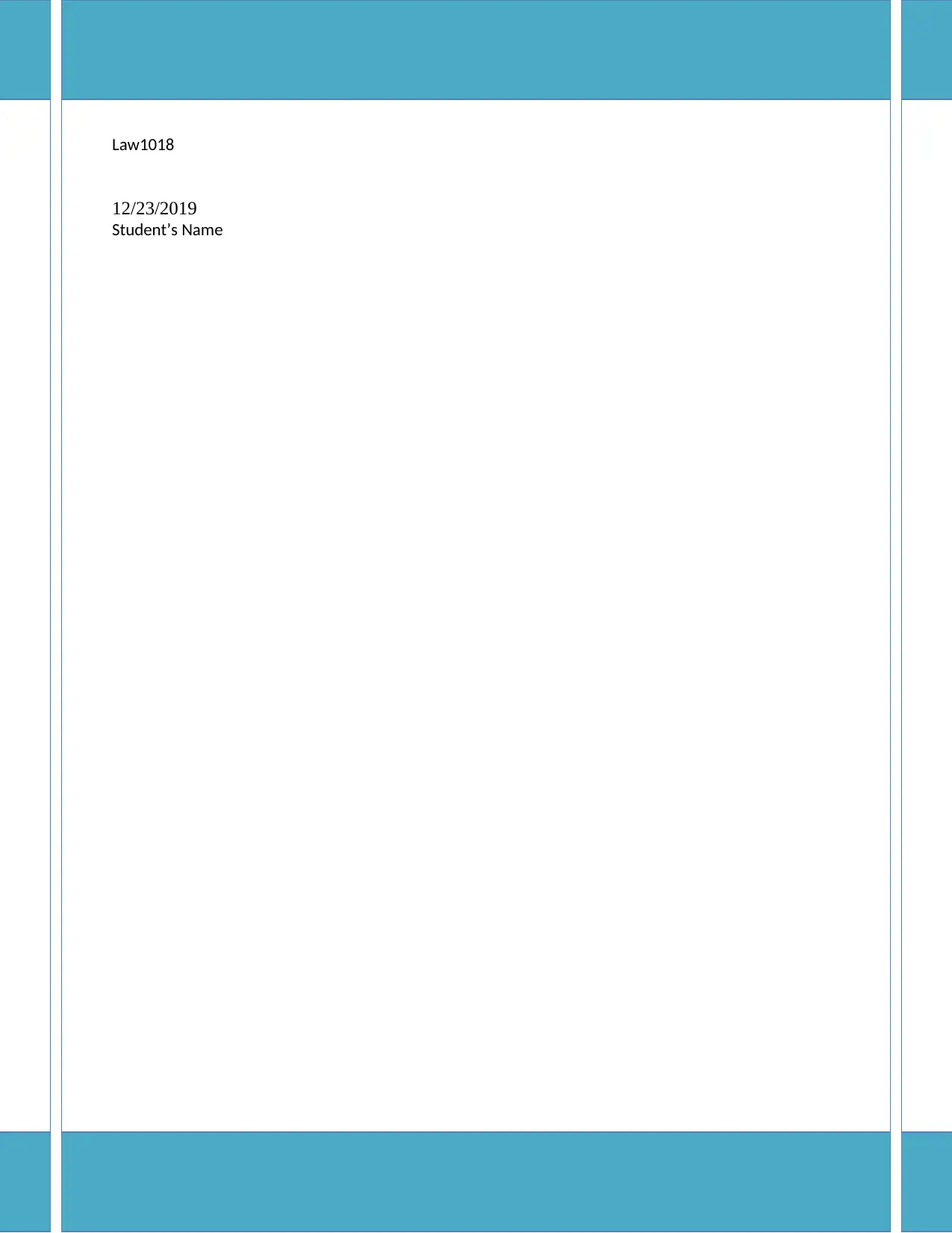
Law1018
12/23/2019
Student’s Name
12/23/2019
Student’s Name
Paraphrase This Document
Need a fresh take? Get an instant paraphrase of this document with our AI Paraphraser
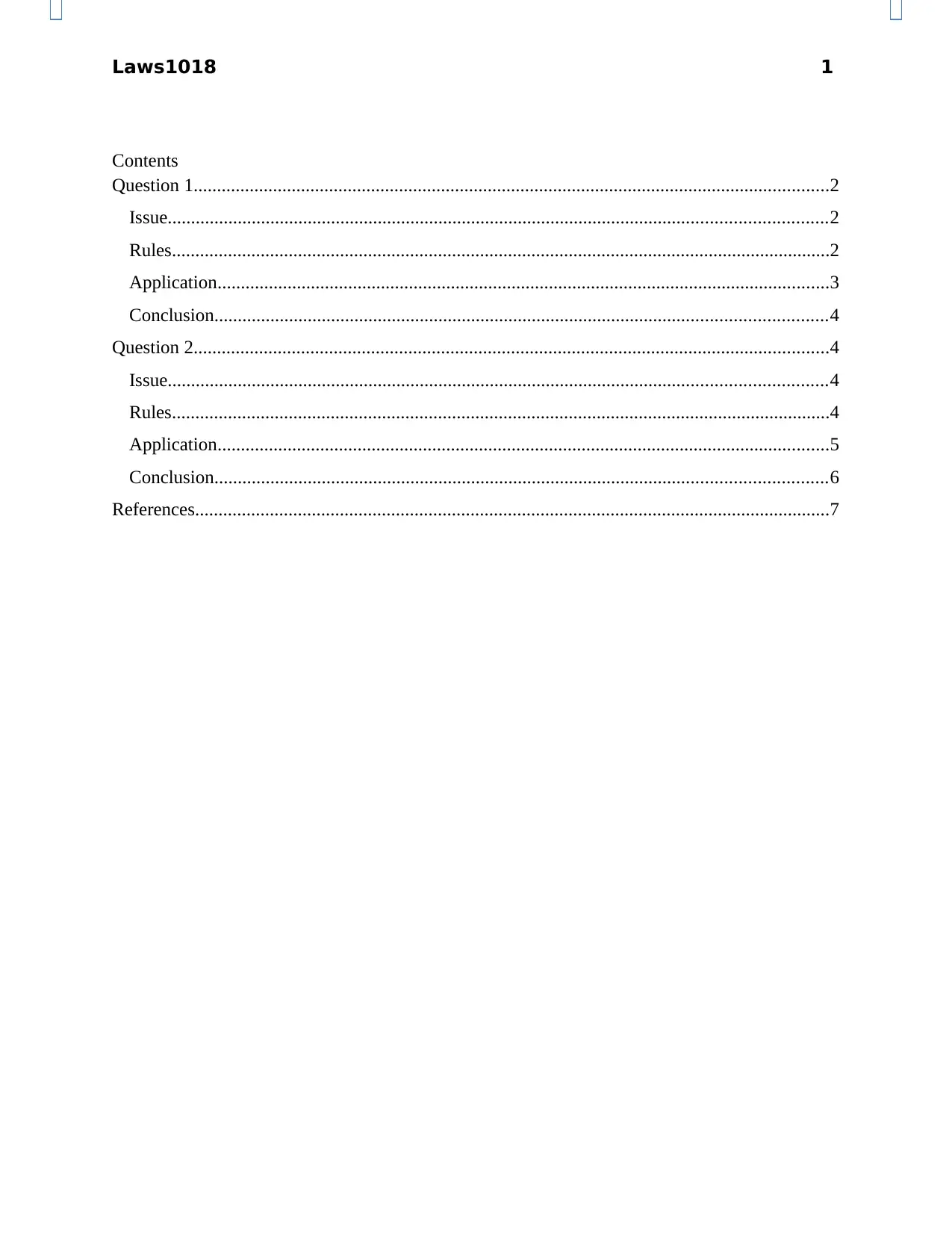
Laws1018 1
Contents
Question 1........................................................................................................................................2
Issue.............................................................................................................................................2
Rules.............................................................................................................................................2
Application...................................................................................................................................3
Conclusion...................................................................................................................................4
Question 2........................................................................................................................................4
Issue.............................................................................................................................................4
Rules.............................................................................................................................................4
Application...................................................................................................................................5
Conclusion...................................................................................................................................6
References........................................................................................................................................7
Contents
Question 1........................................................................................................................................2
Issue.............................................................................................................................................2
Rules.............................................................................................................................................2
Application...................................................................................................................................3
Conclusion...................................................................................................................................4
Question 2........................................................................................................................................4
Issue.............................................................................................................................................4
Rules.............................................................................................................................................4
Application...................................................................................................................................5
Conclusion...................................................................................................................................6
References........................................................................................................................................7
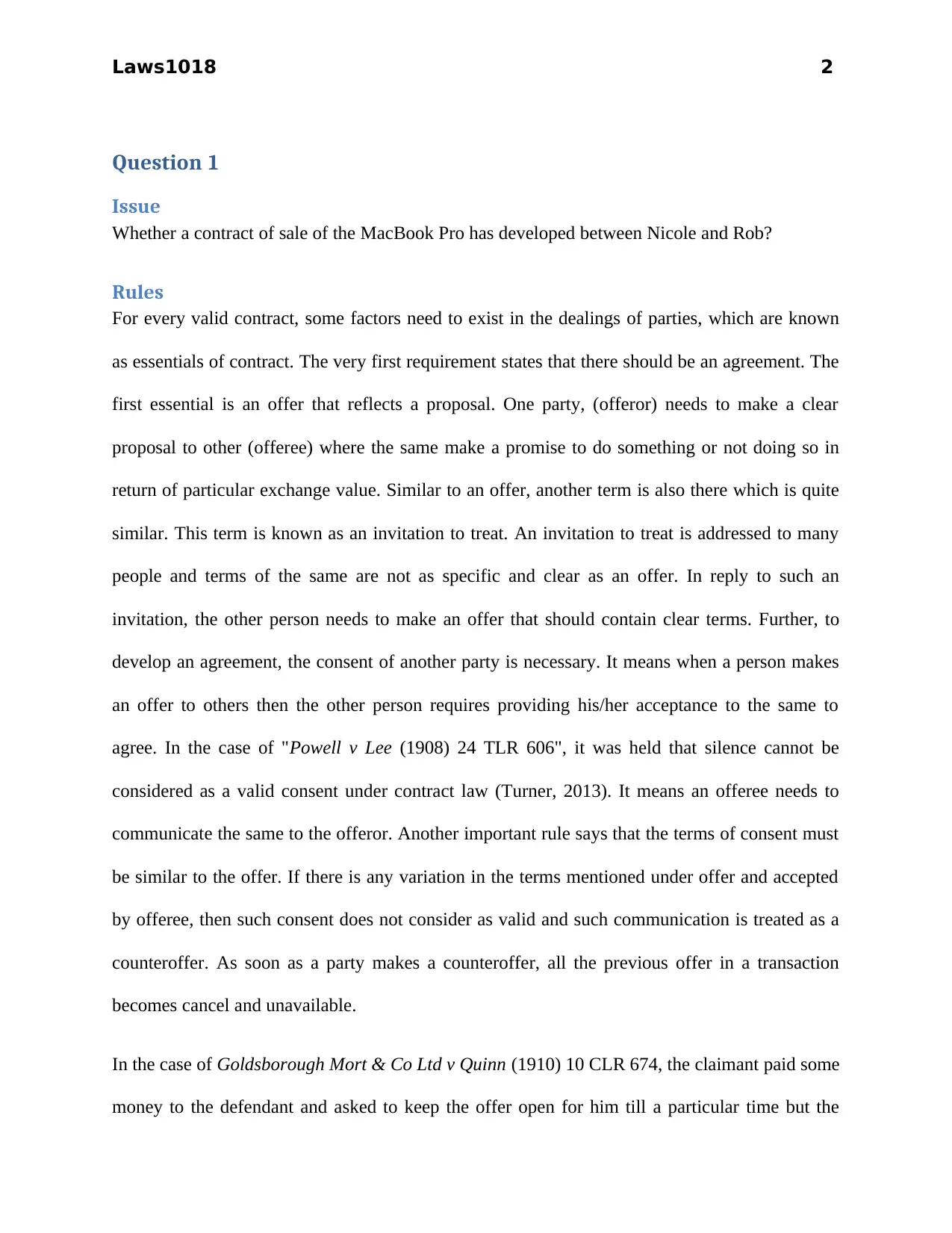
Laws1018 2
Question 1
Issue
Whether a contract of sale of the MacBook Pro has developed between Nicole and Rob?
Rules
For every valid contract, some factors need to exist in the dealings of parties, which are known
as essentials of contract. The very first requirement states that there should be an agreement. The
first essential is an offer that reflects a proposal. One party, (offeror) needs to make a clear
proposal to other (offeree) where the same make a promise to do something or not doing so in
return of particular exchange value. Similar to an offer, another term is also there which is quite
similar. This term is known as an invitation to treat. An invitation to treat is addressed to many
people and terms of the same are not as specific and clear as an offer. In reply to such an
invitation, the other person needs to make an offer that should contain clear terms. Further, to
develop an agreement, the consent of another party is necessary. It means when a person makes
an offer to others then the other person requires providing his/her acceptance to the same to
agree. In the case of "Powell v Lee (1908) 24 TLR 606", it was held that silence cannot be
considered as a valid consent under contract law (Turner, 2013). It means an offeree needs to
communicate the same to the offeror. Another important rule says that the terms of consent must
be similar to the offer. If there is any variation in the terms mentioned under offer and accepted
by offeree, then such consent does not consider as valid and such communication is treated as a
counteroffer. As soon as a party makes a counteroffer, all the previous offer in a transaction
becomes cancel and unavailable.
In the case of Goldsborough Mort & Co Ltd v Quinn (1910) 10 CLR 674, the claimant paid some
money to the defendant and asked to keep the offer open for him till a particular time but the
Question 1
Issue
Whether a contract of sale of the MacBook Pro has developed between Nicole and Rob?
Rules
For every valid contract, some factors need to exist in the dealings of parties, which are known
as essentials of contract. The very first requirement states that there should be an agreement. The
first essential is an offer that reflects a proposal. One party, (offeror) needs to make a clear
proposal to other (offeree) where the same make a promise to do something or not doing so in
return of particular exchange value. Similar to an offer, another term is also there which is quite
similar. This term is known as an invitation to treat. An invitation to treat is addressed to many
people and terms of the same are not as specific and clear as an offer. In reply to such an
invitation, the other person needs to make an offer that should contain clear terms. Further, to
develop an agreement, the consent of another party is necessary. It means when a person makes
an offer to others then the other person requires providing his/her acceptance to the same to
agree. In the case of "Powell v Lee (1908) 24 TLR 606", it was held that silence cannot be
considered as a valid consent under contract law (Turner, 2013). It means an offeree needs to
communicate the same to the offeror. Another important rule says that the terms of consent must
be similar to the offer. If there is any variation in the terms mentioned under offer and accepted
by offeree, then such consent does not consider as valid and such communication is treated as a
counteroffer. As soon as a party makes a counteroffer, all the previous offer in a transaction
becomes cancel and unavailable.
In the case of Goldsborough Mort & Co Ltd v Quinn (1910) 10 CLR 674, the claimant paid some
money to the defendant and asked to keep the offer open for him till a particular time but the
⊘ This is a preview!⊘
Do you want full access?
Subscribe today to unlock all pages.

Trusted by 1+ million students worldwide
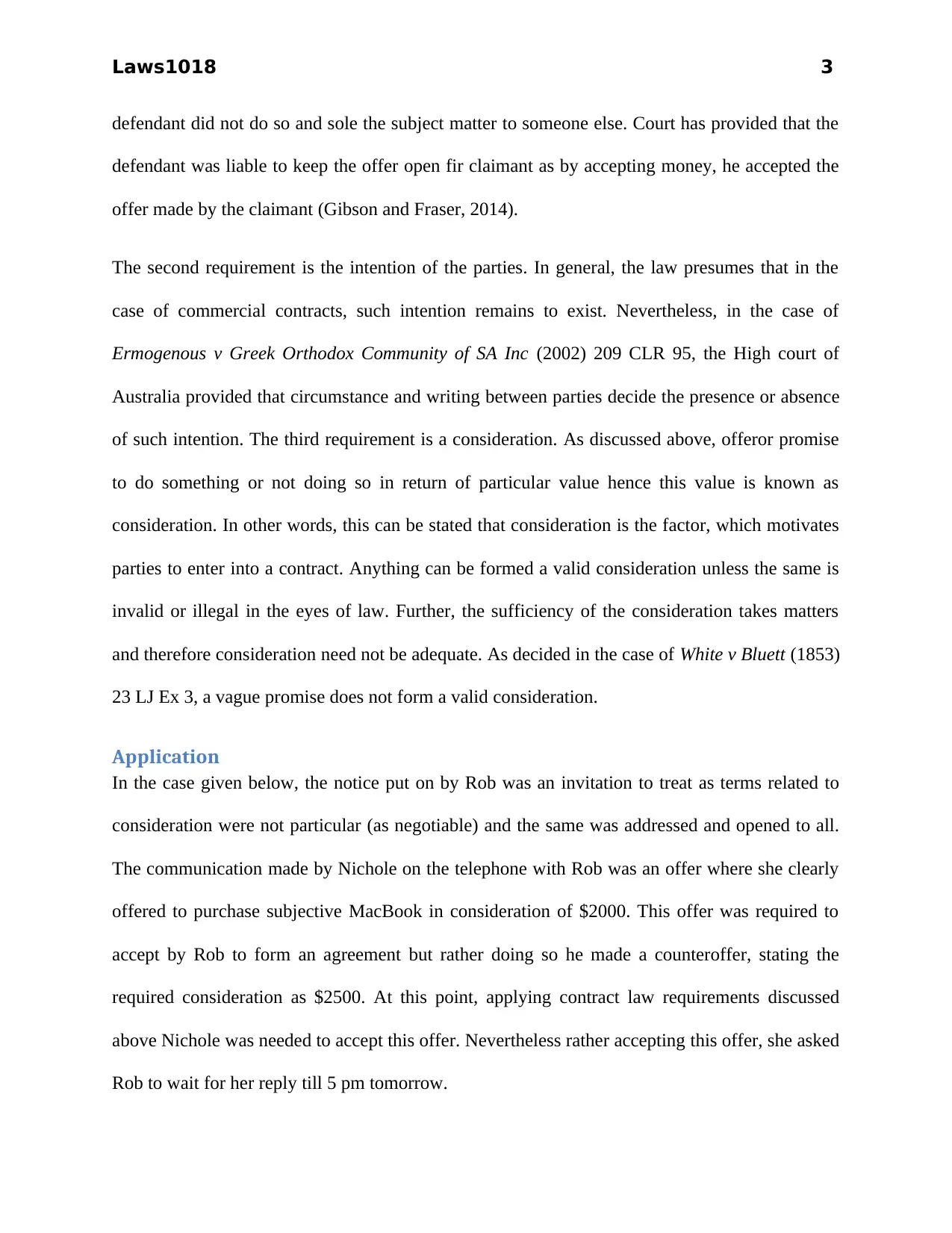
Laws1018 3
defendant did not do so and sole the subject matter to someone else. Court has provided that the
defendant was liable to keep the offer open fir claimant as by accepting money, he accepted the
offer made by the claimant (Gibson and Fraser, 2014).
The second requirement is the intention of the parties. In general, the law presumes that in the
case of commercial contracts, such intention remains to exist. Nevertheless, in the case of
Ermogenous v Greek Orthodox Community of SA Inc (2002) 209 CLR 95, the High court of
Australia provided that circumstance and writing between parties decide the presence or absence
of such intention. The third requirement is a consideration. As discussed above, offeror promise
to do something or not doing so in return of particular value hence this value is known as
consideration. In other words, this can be stated that consideration is the factor, which motivates
parties to enter into a contract. Anything can be formed a valid consideration unless the same is
invalid or illegal in the eyes of law. Further, the sufficiency of the consideration takes matters
and therefore consideration need not be adequate. As decided in the case of White v Bluett (1853)
23 LJ Ex 3, a vague promise does not form a valid consideration.
Application
In the case given below, the notice put on by Rob was an invitation to treat as terms related to
consideration were not particular (as negotiable) and the same was addressed and opened to all.
The communication made by Nichole on the telephone with Rob was an offer where she clearly
offered to purchase subjective MacBook in consideration of $2000. This offer was required to
accept by Rob to form an agreement but rather doing so he made a counteroffer, stating the
required consideration as $2500. At this point, applying contract law requirements discussed
above Nichole was needed to accept this offer. Nevertheless rather accepting this offer, she asked
Rob to wait for her reply till 5 pm tomorrow.
defendant did not do so and sole the subject matter to someone else. Court has provided that the
defendant was liable to keep the offer open fir claimant as by accepting money, he accepted the
offer made by the claimant (Gibson and Fraser, 2014).
The second requirement is the intention of the parties. In general, the law presumes that in the
case of commercial contracts, such intention remains to exist. Nevertheless, in the case of
Ermogenous v Greek Orthodox Community of SA Inc (2002) 209 CLR 95, the High court of
Australia provided that circumstance and writing between parties decide the presence or absence
of such intention. The third requirement is a consideration. As discussed above, offeror promise
to do something or not doing so in return of particular value hence this value is known as
consideration. In other words, this can be stated that consideration is the factor, which motivates
parties to enter into a contract. Anything can be formed a valid consideration unless the same is
invalid or illegal in the eyes of law. Further, the sufficiency of the consideration takes matters
and therefore consideration need not be adequate. As decided in the case of White v Bluett (1853)
23 LJ Ex 3, a vague promise does not form a valid consideration.
Application
In the case given below, the notice put on by Rob was an invitation to treat as terms related to
consideration were not particular (as negotiable) and the same was addressed and opened to all.
The communication made by Nichole on the telephone with Rob was an offer where she clearly
offered to purchase subjective MacBook in consideration of $2000. This offer was required to
accept by Rob to form an agreement but rather doing so he made a counteroffer, stating the
required consideration as $2500. At this point, applying contract law requirements discussed
above Nichole was needed to accept this offer. Nevertheless rather accepting this offer, she asked
Rob to wait for her reply till 5 pm tomorrow.
Paraphrase This Document
Need a fresh take? Get an instant paraphrase of this document with our AI Paraphraser
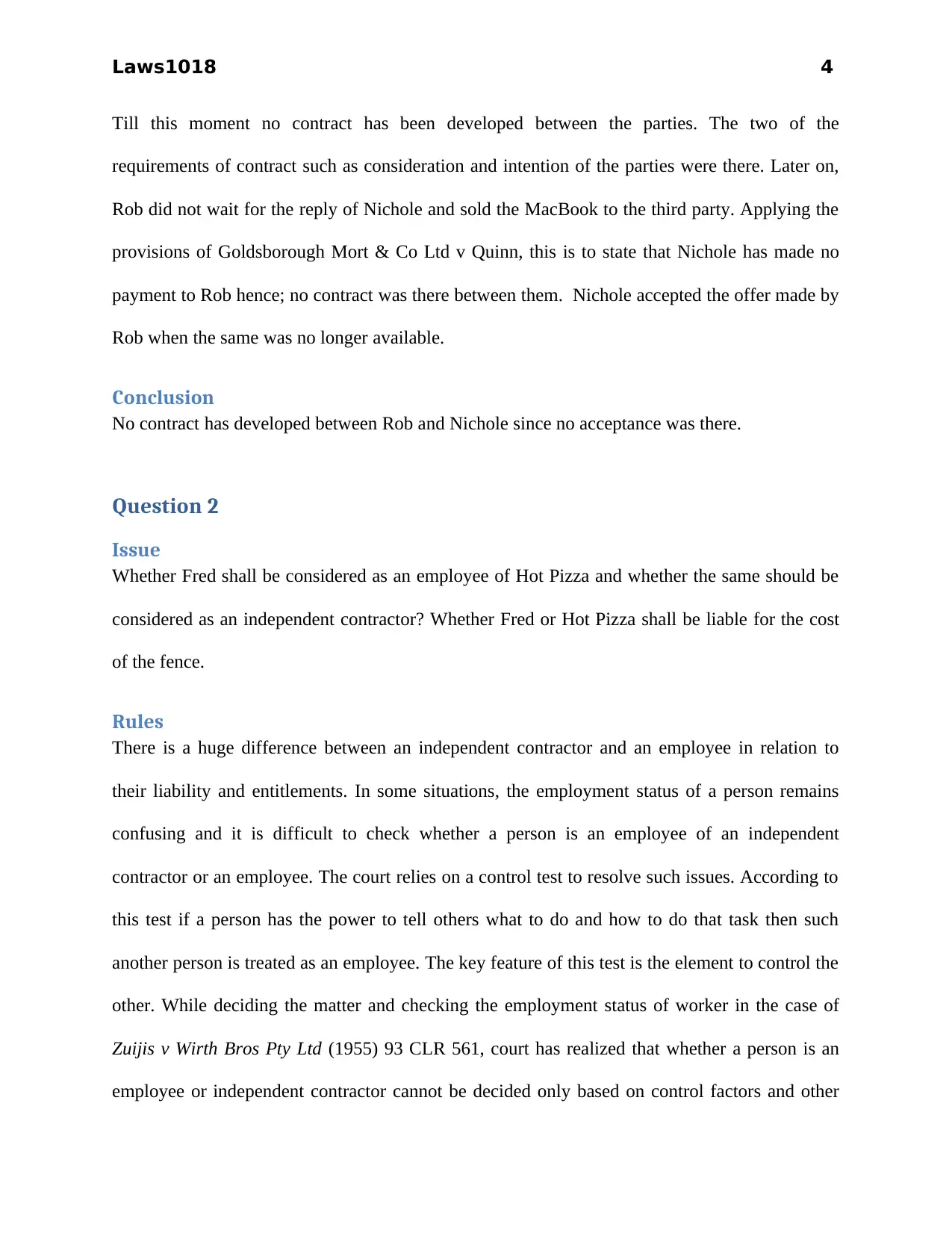
Laws1018 4
Till this moment no contract has been developed between the parties. The two of the
requirements of contract such as consideration and intention of the parties were there. Later on,
Rob did not wait for the reply of Nichole and sold the MacBook to the third party. Applying the
provisions of Goldsborough Mort & Co Ltd v Quinn, this is to state that Nichole has made no
payment to Rob hence; no contract was there between them. Nichole accepted the offer made by
Rob when the same was no longer available.
Conclusion
No contract has developed between Rob and Nichole since no acceptance was there.
Question 2
Issue
Whether Fred shall be considered as an employee of Hot Pizza and whether the same should be
considered as an independent contractor? Whether Fred or Hot Pizza shall be liable for the cost
of the fence.
Rules
There is a huge difference between an independent contractor and an employee in relation to
their liability and entitlements. In some situations, the employment status of a person remains
confusing and it is difficult to check whether a person is an employee of an independent
contractor or an employee. The court relies on a control test to resolve such issues. According to
this test if a person has the power to tell others what to do and how to do that task then such
another person is treated as an employee. The key feature of this test is the element to control the
other. While deciding the matter and checking the employment status of worker in the case of
Zuijis v Wirth Bros Pty Ltd (1955) 93 CLR 561, court has realized that whether a person is an
employee or independent contractor cannot be decided only based on control factors and other
Till this moment no contract has been developed between the parties. The two of the
requirements of contract such as consideration and intention of the parties were there. Later on,
Rob did not wait for the reply of Nichole and sold the MacBook to the third party. Applying the
provisions of Goldsborough Mort & Co Ltd v Quinn, this is to state that Nichole has made no
payment to Rob hence; no contract was there between them. Nichole accepted the offer made by
Rob when the same was no longer available.
Conclusion
No contract has developed between Rob and Nichole since no acceptance was there.
Question 2
Issue
Whether Fred shall be considered as an employee of Hot Pizza and whether the same should be
considered as an independent contractor? Whether Fred or Hot Pizza shall be liable for the cost
of the fence.
Rules
There is a huge difference between an independent contractor and an employee in relation to
their liability and entitlements. In some situations, the employment status of a person remains
confusing and it is difficult to check whether a person is an employee of an independent
contractor or an employee. The court relies on a control test to resolve such issues. According to
this test if a person has the power to tell others what to do and how to do that task then such
another person is treated as an employee. The key feature of this test is the element to control the
other. While deciding the matter and checking the employment status of worker in the case of
Zuijis v Wirth Bros Pty Ltd (1955) 93 CLR 561, court has realized that whether a person is an
employee or independent contractor cannot be decided only based on control factors and other
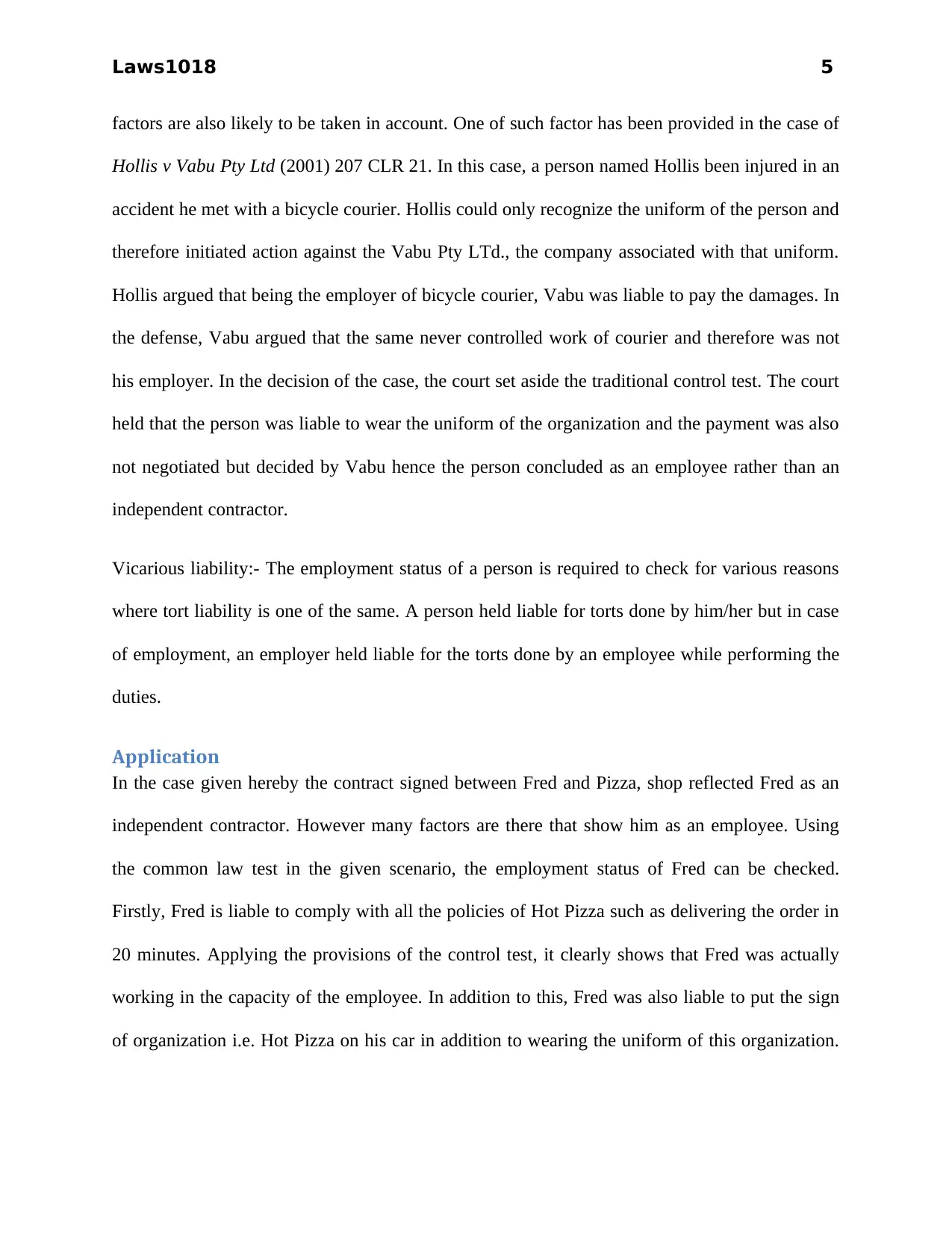
Laws1018 5
factors are also likely to be taken in account. One of such factor has been provided in the case of
Hollis v Vabu Pty Ltd (2001) 207 CLR 21. In this case, a person named Hollis been injured in an
accident he met with a bicycle courier. Hollis could only recognize the uniform of the person and
therefore initiated action against the Vabu Pty LTd., the company associated with that uniform.
Hollis argued that being the employer of bicycle courier, Vabu was liable to pay the damages. In
the defense, Vabu argued that the same never controlled work of courier and therefore was not
his employer. In the decision of the case, the court set aside the traditional control test. The court
held that the person was liable to wear the uniform of the organization and the payment was also
not negotiated but decided by Vabu hence the person concluded as an employee rather than an
independent contractor.
Vicarious liability:- The employment status of a person is required to check for various reasons
where tort liability is one of the same. A person held liable for torts done by him/her but in case
of employment, an employer held liable for the torts done by an employee while performing the
duties.
Application
In the case given hereby the contract signed between Fred and Pizza, shop reflected Fred as an
independent contractor. However many factors are there that show him as an employee. Using
the common law test in the given scenario, the employment status of Fred can be checked.
Firstly, Fred is liable to comply with all the policies of Hot Pizza such as delivering the order in
20 minutes. Applying the provisions of the control test, it clearly shows that Fred was actually
working in the capacity of the employee. In addition to this, Fred was also liable to put the sign
of organization i.e. Hot Pizza on his car in addition to wearing the uniform of this organization.
factors are also likely to be taken in account. One of such factor has been provided in the case of
Hollis v Vabu Pty Ltd (2001) 207 CLR 21. In this case, a person named Hollis been injured in an
accident he met with a bicycle courier. Hollis could only recognize the uniform of the person and
therefore initiated action against the Vabu Pty LTd., the company associated with that uniform.
Hollis argued that being the employer of bicycle courier, Vabu was liable to pay the damages. In
the defense, Vabu argued that the same never controlled work of courier and therefore was not
his employer. In the decision of the case, the court set aside the traditional control test. The court
held that the person was liable to wear the uniform of the organization and the payment was also
not negotiated but decided by Vabu hence the person concluded as an employee rather than an
independent contractor.
Vicarious liability:- The employment status of a person is required to check for various reasons
where tort liability is one of the same. A person held liable for torts done by him/her but in case
of employment, an employer held liable for the torts done by an employee while performing the
duties.
Application
In the case given hereby the contract signed between Fred and Pizza, shop reflected Fred as an
independent contractor. However many factors are there that show him as an employee. Using
the common law test in the given scenario, the employment status of Fred can be checked.
Firstly, Fred is liable to comply with all the policies of Hot Pizza such as delivering the order in
20 minutes. Applying the provisions of the control test, it clearly shows that Fred was actually
working in the capacity of the employee. In addition to this, Fred was also liable to put the sign
of organization i.e. Hot Pizza on his car in addition to wearing the uniform of this organization.
⊘ This is a preview!⊘
Do you want full access?
Subscribe today to unlock all pages.

Trusted by 1+ million students worldwide
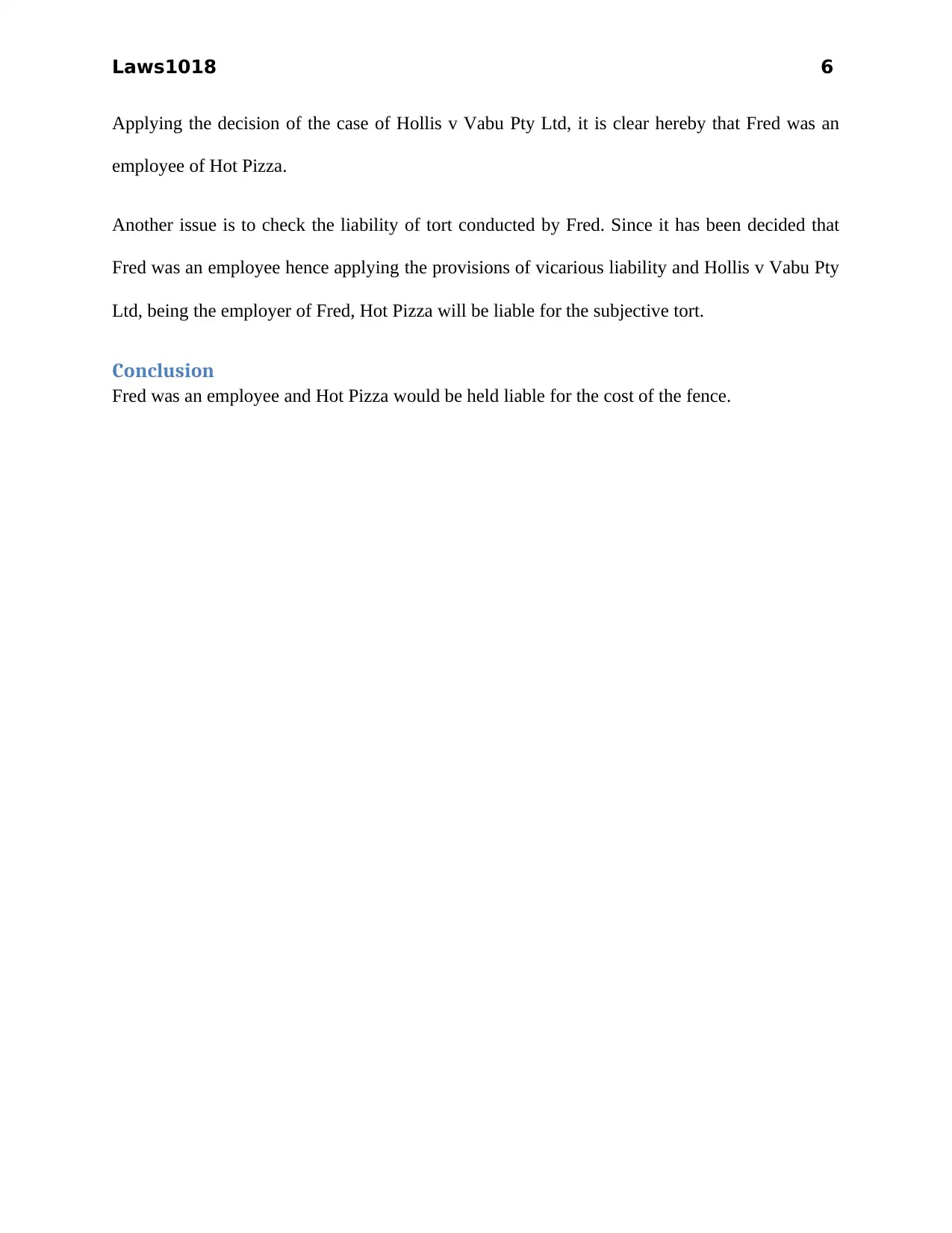
Laws1018 6
Applying the decision of the case of Hollis v Vabu Pty Ltd, it is clear hereby that Fred was an
employee of Hot Pizza.
Another issue is to check the liability of tort conducted by Fred. Since it has been decided that
Fred was an employee hence applying the provisions of vicarious liability and Hollis v Vabu Pty
Ltd, being the employer of Fred, Hot Pizza will be liable for the subjective tort.
Conclusion
Fred was an employee and Hot Pizza would be held liable for the cost of the fence.
Applying the decision of the case of Hollis v Vabu Pty Ltd, it is clear hereby that Fred was an
employee of Hot Pizza.
Another issue is to check the liability of tort conducted by Fred. Since it has been decided that
Fred was an employee hence applying the provisions of vicarious liability and Hollis v Vabu Pty
Ltd, being the employer of Fred, Hot Pizza will be liable for the subjective tort.
Conclusion
Fred was an employee and Hot Pizza would be held liable for the cost of the fence.
Paraphrase This Document
Need a fresh take? Get an instant paraphrase of this document with our AI Paraphraser
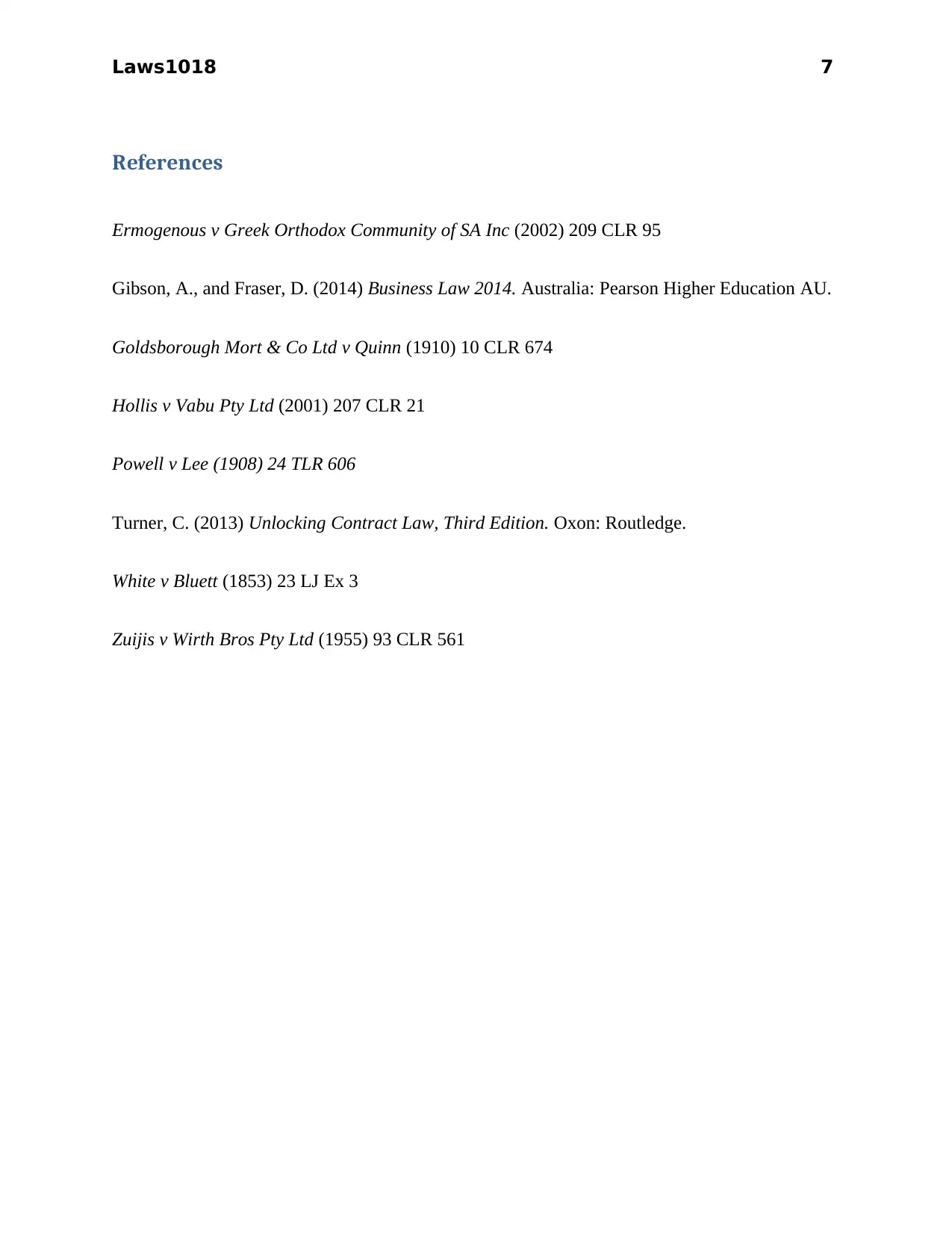
Laws1018 7
References
Ermogenous v Greek Orthodox Community of SA Inc (2002) 209 CLR 95
Gibson, A., and Fraser, D. (2014) Business Law 2014. Australia: Pearson Higher Education AU.
Goldsborough Mort & Co Ltd v Quinn (1910) 10 CLR 674
Hollis v Vabu Pty Ltd (2001) 207 CLR 21
Powell v Lee (1908) 24 TLR 606
Turner, C. (2013) Unlocking Contract Law, Third Edition. Oxon: Routledge.
White v Bluett (1853) 23 LJ Ex 3
Zuijis v Wirth Bros Pty Ltd (1955) 93 CLR 561
References
Ermogenous v Greek Orthodox Community of SA Inc (2002) 209 CLR 95
Gibson, A., and Fraser, D. (2014) Business Law 2014. Australia: Pearson Higher Education AU.
Goldsborough Mort & Co Ltd v Quinn (1910) 10 CLR 674
Hollis v Vabu Pty Ltd (2001) 207 CLR 21
Powell v Lee (1908) 24 TLR 606
Turner, C. (2013) Unlocking Contract Law, Third Edition. Oxon: Routledge.
White v Bluett (1853) 23 LJ Ex 3
Zuijis v Wirth Bros Pty Ltd (1955) 93 CLR 561
1 out of 8
Related Documents
Your All-in-One AI-Powered Toolkit for Academic Success.
+13062052269
info@desklib.com
Available 24*7 on WhatsApp / Email
![[object Object]](/_next/static/media/star-bottom.7253800d.svg)
Unlock your academic potential
Copyright © 2020–2025 A2Z Services. All Rights Reserved. Developed and managed by ZUCOL.





